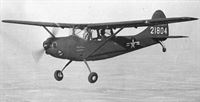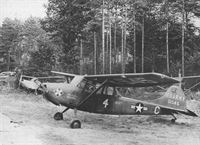Фотографии
-
An Air Force O-1E evaluates the effect of saturation bombing by B-52s on jungle in South Vietnam in 1966.
Самолёты на фотографии: Cessna L-19 / O-1 Bird dog / Model 305 - США - 1950
-
Регистрационный номер: JG-1051 Hal Lomis flying his Fuji-built L-19 Susui, painted in Japanese Self Defence Force livery;
Самолёты на фотографии: Cessna L-19 / O-1 Bird dog / Model 305 - США - 1950
-
John Madison's L-19A painted in Civil Air Patrol markings.
Самолёты на фотографии: Cessna L-19 / O-1 Bird dog / Model 305 - США - 1950
-
Larry Flinn's San Antonio-based Bird Dog.
Самолёты на фотографии: Cessna L-19 / O-1 Bird dog / Model 305 - США - 1950
-
Регистрационный номер: N88RN FRANK MORMILLO’s shot of Paul Vought's Chilly Willy, an O-1F, in formation with Ralph Nelson’s O-1E 52-4551 and the same owner's N88RN Dog Spot.
Самолёты на фотографии: Cessna L-19 / O-1 Bird dog / Model 305 - США - 1950
-
More than 100 Bird Dog trainers awaiting student pilots at Lowe Army Airfield, Fort Rucker, Alabama, the home of Army aviation.
Самолёты на фотографии: Cessna L-19 / O-1 Bird dog / Model 305 - США - 1950
-
In its heyday the Bird Dog could climb at a steeper angle than any other lightplane in its class.
Самолёты на фотографии: Cessna L-19 / O-1 Bird dog / Model 305 - США - 1950
-
The gas-turbine powered XL-19B, which set a lightplane altitude record of 37,063 ft.
Самолёты на фотографии: Cessna L-19 / O-1 Bird dog / Model 305 - США - 1950
-
A Kentucky National Guard Bird Dog in the glossy green uniform of 1963. The ADF loop antenna and the long FM whip antenna are familiar trademarks of the O-1.
Самолёты на фотографии: Cessna L-19 / O-1 Bird dog / Model 305 - США - 1950
-
In 1965 Army student pilots flew these multi-coloured (dull orange and olive drab) Bird Dogs on training missions from this bivouac site near Fort Rucker, Alabama.
Самолёты на фотографии: Cessna L-19 / O-1 Bird dog / Model 305 - США - 1950
-
Further view of XL-19B 52-1804, which shattered the world’s altitude record for its weight category. The aircraft is fitted with a Boeing XT50-1 gas turbine engine of 210 e.h.p., and made its first flight with this engine on November 5, 1952.
Самолёты на фотографии: Cessna L-19 / O-1 Bird dog / Model 305 - США - 1950
-
Самолёты на фотографии: Cessna L-19 / O-1 Bird dog / Model 305 - США - 1950
-
A TL-19D, used to train Army pilots and fitted with dual control. The type went into service during the late Fifties.
Самолёты на фотографии: Cessna L-19 / O-1 Bird dog / Model 305 - США - 1950
-
John Madison's L-19A painted in Civil Air Patrol markings.
Самолёты на фотографии: Cessna L-19 / O-1 Bird dog / Model 305 - США - 1950
Статьи
- -
- Douglas SBD-5 Dauntless N670AM/Bu No 28536 /Preservation Profile/
- Personal album. Civil
- Personal album. Military
- A.Ebbers - Bird Dog. The last affordable warbird
- A.Lumsden, T.Heffernan - Per Mare Probare (15)
- B.Livingstone - Strine Nine
- F.Hislop - Memories (1)
- G.Levett - From Penguin into Eagle (4)
- H.Levy - Travel Air 4-D
- J.Meadows - A Decisive Factor (4)
- J.Stroud - Wings of Peace
- M.Oakey - Grapevine
- R.Swain - Lincoln Rigger
- S.Harding - The Reluctant Dominator (2)













